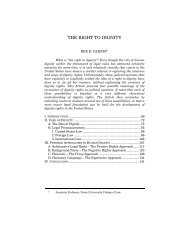A Right to Media? Lorie M. Graham - Columbia Law School
A Right to Media? Lorie M. Graham - Columbia Law School
A Right to Media? Lorie M. Graham - Columbia Law School
Create successful ePaper yourself
Turn your PDF publications into a flip-book with our unique Google optimized e-Paper software.
2010] A RIGHT TO MEDIA? 431<br />
expression and the right <strong>to</strong> receive information. As formulated, the<br />
right <strong>to</strong> media supports other core rights impacting indigenous<br />
peoples, such as the rights <strong>to</strong> non-discrimination, self-determination,<br />
and respect for cultural integrity. Thus, the aims of this Article are<br />
twofold: <strong>to</strong> articulate a right <strong>to</strong> media based upon preexisting<br />
international human rights norms and then <strong>to</strong> demonstrate how<br />
recognition of this right can promote voices in the media that have<br />
been his<strong>to</strong>rically missing or silenced, such as those of indigenous<br />
peoples.<br />
Part IV looks beyond the question of rights and explores more<br />
fully how these rights are being shaped and advanced by the<br />
movement for media pluralism at the regional and domestic levels. In<br />
doing so, this part identifies a number of fac<strong>to</strong>rs that need <strong>to</strong> be<br />
present at the domestic level in order <strong>to</strong> ensure a right <strong>to</strong> media for<br />
indigenous peoples. Finally, the Conclusion discusses the larger role<br />
that media rights can play in promoting other important societal<br />
norms, such as the promotion of peace and <strong>to</strong>lerance among societies.<br />
II. INDIGENOUS PEOPLES AND MEDIA<br />
This section discusses the research on the his<strong>to</strong>rical<br />
relationship between media and indigenous peoples and how<br />
concerns over indigenous peoples’ rights led <strong>to</strong> the UNDRIP. This<br />
discussion will reveal two key fac<strong>to</strong>rs that have limited indigenous<br />
peoples’ rights <strong>to</strong> access mass media. The first can be analyzed as a<br />
structural barrier. This includes such things as the cost of the<br />
training and technology needed <strong>to</strong> access and produce mass media,<br />
which studies show has been his<strong>to</strong>rically prohibitive. 6 It also includes<br />
the infrastructure required for the use of media, which has proven <strong>to</strong><br />
be problematic for financial as well as logistical reasons, as many<br />
indigenous peoples have lived in rural and remote areas. Thus the<br />
technology needed <strong>to</strong> access media has “only [been] accessible <strong>to</strong><br />
indigenous peoples through the apparatus and materials of others,<br />
with the consequent restrictions and dangers of manipulation and<br />
pressure.” 7 The second fac<strong>to</strong>r contributing <strong>to</strong> the inability of<br />
6. See generally U.N. Econ. & Soc. Council [ECOSOC], Sub-Comm’n on<br />
Prevention of Discrimination and Prot. of Minorities, Study of the Problem of<br />
Discrimination Against Indigenous Populations, para. 140, U.N. Doc.<br />
E/CN.4/Sub.2/1983/21/Add.8 (Sept. 30, 1983) (prepared by Jose Martinez Cobo)<br />
[hereinafter Martinez Cobo Sept. Report] (studying and reporting on the methods<br />
taken <strong>to</strong> protect indigenous peoples).<br />
7. Id.















